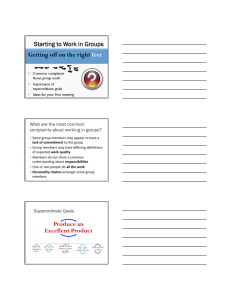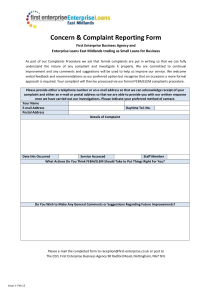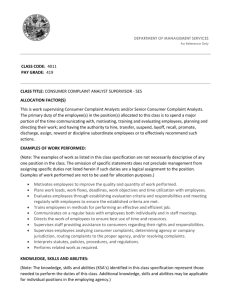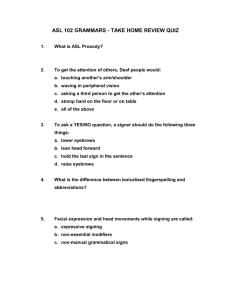Unit Plan - George Mason University
advertisement
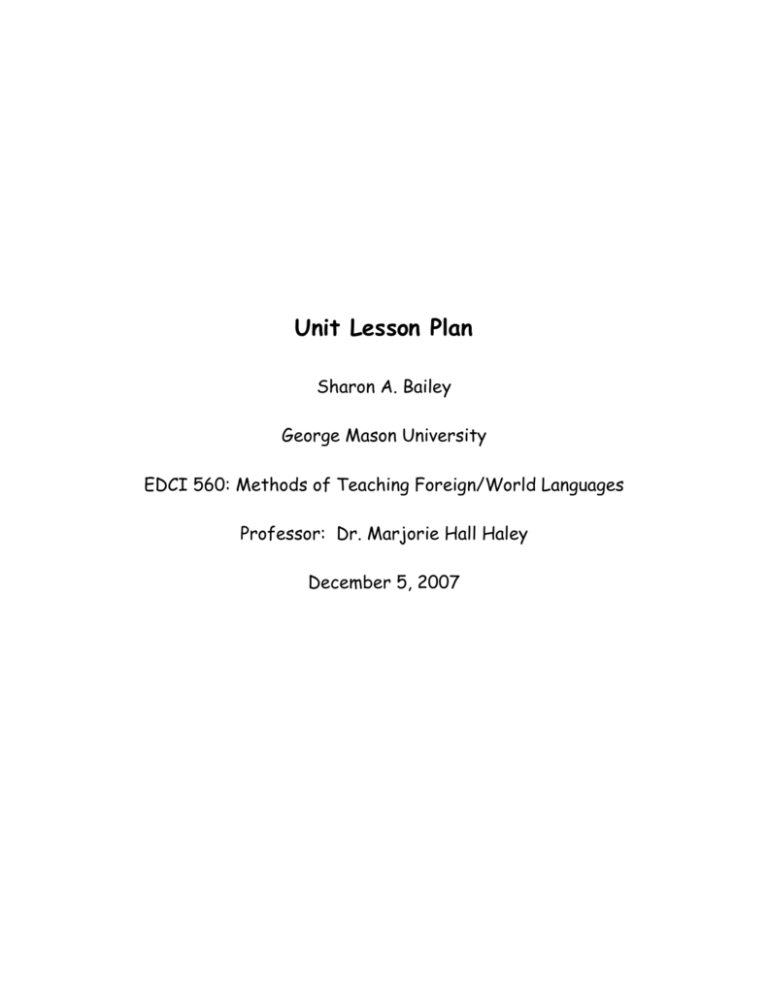
Unit Lesson Plan Sharon A. Bailey George Mason University EDCI 560: Methods of Teaching Foreign/World Languages Professor: Dr. Marjorie Hall Haley December 5, 2007 Teacher: Sharon A. Bailey Grades: 11-12 Date: December 4, 2007 I. Unit Lesson Plans School: West Springfield High School Language: American Sign Language Number of Students: 28 Time: 90 minutes Planning Phase a. Identify Performance Objectives i. Students will be able to participate in a sustained conversation with an assigned prompt of making a request, suggestion, or complaint. ii. Students will be able to narrate the story “One Fine Day” using frozen register. iii. Students will be able to create a presentation/commercial incorporating requests, suggestions, and or complaints about health ailments. b. Standards National (ACTFL) *Standard 1.1 Students engage in conversation, provide and obtain information, express feelings, and emotions, and exchange opinions. *Standard 1.3 Students present information, concepts, and ideas to an audience of listeners on a variety of topics. *Standard 4.1 Students demonstrate understanding of the nature of language through comparisons of the language studied and their own. Virginia State Modern Foreign Language Standards MFLIII 1.1 Express own opinions. MFLIII 1.2 Use level appropriate vocabulary and structures to express ideals about events. MFLIII 3.1 Identify main ideas and details when reading. MFLIII 3.3 Understand and follow instructions presented in consumer and informational materials in ASL. MFLIII 7.0 The student will reinforce and broaden his/her knowledge of connections between ASL and other subject areas. MFLIII 10.0 The student will improve foreign language skills and expand cultural understanding by accessing information beyond the classroom setting for recreational, educational, and occupational purpose. Fairfax County Public Schools/Local Local standards are aligned with state and national standards. Day 1: Health and Ailments II. Teaching Phase a. Preparation: i. Warm Up Activity: Student lead (3). Each student leader will teach their assigned vocabulary to their group. Each group will rotate 3 times. (Textbook required) ii. Theme or Topic: Signing Naturally Unit 14: Complaints, Requests, and Suggestions iii. Day’s Objectives: Students will be able to use vocabulary and sentence structures for complaining about physical conditions, making suggestions, and responding appropriately when given a prompt/picture. iv. Verbs: Review transitive sentence structure in English as it relates to Topic-Comment in ASL; Compare repetitive and continuous verbs in ASL and in the English language v. Grammar Structure: 1. Suggestion + remedy + pronoun 2. Complaints + time sign + action [me} SICK-OF vi. Reading/Viewing selections: Dialogues based on requests, suggestions, or complaints. b. Presentation i. Activities 1. PP Hospital Signs-Teacher will review and introduce signs using real-life situations/pictures 2. Groups of 4: Teacher will pass out situation cards/pictures. Students will discuss, plan, and execute each prompt. Each group will role-play using the correct vocabulary presented in class. Groups will present one situation for the class. 3. Video Work/Worksheet: Students will view dialogues and notice how the signers use agreement verbs and pronouns. After watching the video, the teacher will go over any questions about the signing/vocabulary. Student will then watch the video again and answer 4 questions per dialogue. 4. Story time: My Worst Day at the Dentist c. Practice i. Interpersonal Activities: Students will be encouraged to add information about the real-life situations/pictures with the teacher using the appropriate vocabulary structure. Students will work together in a group reviewing/learning new vocabulary using a model. Students will be grouped and given role-playing situations to incorporate new vocabulary. ii. Presentational Activities: Students will present one roleplaying scenario to the class using requests, suggestions, and or complains. iii. Interpretive Activities: Students will view the dialogue and answer questions. d. Evaluation i. Student’s work (worksheet) on the dialogues will be collected and graded for accuracy. ii. Vocabulary practice/review will be assigned on 24/7 (Blackboard). Students can retake the assignment 3 times-last grade will be recorded. e. Expansion/Extension i. Vocabulary Check: Pictures/Signs-Students will write the correct English equivalent for each picture. Student can check their responses by using their textbooks. ii. Picture It! Teacher will tell a situation and the students will have to choose the correct picture it represents. (10) f. Methods/Approaches/Strategies i. TPR, Direct Method III. Other Activities: a. Follow-up b. c. d. e. i. Cultural Information: Discuss the ADA and the medical community in regards to Deaf patients. ii. Lab time: Student will locate and report on Deaf community problems within the community due to the lack of ADA compliance issues. Assessment i. See evaluation Homework assignments i. 24/7 activity-Vocabulary check/reading 2 articles online/YOU TUBE video clip on ADA compliance issue Use of technology i. LCD projector ii. Signing Naturally II Video iii. Lab/library computers iv. Internet/YOU TUBE Materials used i. Laptop computer ii. Power Point presentation iii. Video tape iv. Medical items v. Worksheet vi. Activity cards/role playing Day 2: Sickness and Health IV. Teaching Phase a. Preparation: i. Warm Up Activity: Class Mixer. Students will have a chart to fill out with the following information: tooth extraction, surgery, broken bones, used crutches, stitches, rode in ambulance, ect. ii. Theme or Topic: Signing Naturally Unit 14: Complaints, Requests, and Suggestions iii. Day’s Objectives: Students will be able to use vocabulary and sentence structures for complaining about physical conditions, making suggestions, and responding appropriately when given a prompt/picture. Students will be able to use inflected and uninflected forms of ailment-verb signs with corresponding time signs. iv. Verbs: Review transitive sentence structure in English as it relates to Topic-Comment in ASL; Compare repetitive and continuous verbs in ASL and in the English language; Temporal aspect of ASL structure; review verb inflection v. Grammar Structure: 1. Complaint +recurring OR +continuous Empathize vi. Reading/Viewing selections: Video tape exercises and transparencies b. Presentation i. Activities 1. After the warm-up the teacher will show pictures and review vocabulary including the following: NOT-FEEL-GOOD, FEEL LOUSY. Using a simple story/narrative sign about my son having an upset stomach—after signing, ask students to identify which picture/illustration matches. (10) 2. Show the “Inflected Forms” transparency. Show how the form of the verb sign may change to agree with the time concept expressed…whether it happened once, was recurring, or was continuous. 3. After introducing all the sign forms, go back and point to either “recurring” or “continuous”—give the uninflected for and ask random students how to sign the inflected form. 4. Review/students take notes from board. 5. Which one? Teacher will sign a sentence; students will sign the verb back using the correct tense. c. Practice i. Interpersonal Activities: Students asked questions relating to health issues. ii. Presentational Activities: Student will sign the correct verb tense when given a prompt. iii. Interpretive Activities: Students will view a video activity and circle the correct response/verb tenses. (18). d. Evaluation i. Inflected Verb activity/Worksheet. After viewing a video segment/or teacher, the student will identify the inflected verb. ii. “Oils and Aromas”. Partner activity. Assign workbook page to each partner. One will ask about a particular illness and the other partner will tell them what the remedy would be…students will write down their partner’s suggestion. iii. Vocabulary practice/review will be assigned on 24/7 (Blackboard). Students can retake the assignment 3 times-last grade will be recorded. e. Expansion/Extension i. Student Response on the article: NAD announces $175,000 settlement with NJ jail-locked up without communication access; deaf man settles discrimination complaint ii. Sign It! Student must use recurring or continuous verb tenses correctly and receives 1 point. If they can do 5 correctly the student receives a homework pass. f. Methods/Approaches/Strategies i. TPR, Direct Method V. Other Activities: a. Follow-up b. c. d. e. i. Discuss the candid observation made by members of the Deaf community about non-compliance issues—like the hiring of interpreters at NOVA. ii. Video clip of hiring of the new president at Gallaudet University. Assessment i. See evaluation Homework assignments i. 24/7 activity-Vocabulary review Use of technology i. LCD projector ii. Signing Naturally II Video Materials used i. Laptop computer ii. Power Point presentation iii. Video tape iv. Worksheets v. Printed article/NAD Day 3: Complaining About Others VI. Teaching Phase a. Preparation: i. Warm Up Activity: Group Work. Each group will list accommodations for Deaf people in each setting: hospitals, airports, DMV, NOVA, hotels, schools, restaurants and churches. Lists will be posted on the back wall. ii. Theme or Topic: Signing Naturally Unit 14: Complaints, Requests, and Suggestions iii. Day’s Objectives: Students will be able to complain about habitual behaviors as well as use vocabulary for empathizing and making suggestions. Students will be able to use mime, classifiers (descriptive, instrument, or element) and correct spatial references as they develop alternative strategies for expressing things they do not know how to sign. iv. Verbs: Review transitive sentence structure in English as it relates to Topic-Comment in ASL; Compare repetitive and continuous verbs in ASL and in the English language; Temporal aspect of ASL structure; review verb inflection v. Grammar Structure: 1. Complaint +recurring OR +continuous Empathize vi. Reading/Viewing selections: Power Point Presentations: People, Poetry “You Have to be Deaf to Understand” b. Presentation i. Activities 1. Complaining about others: Pets, children, roommates, neighbors, sisters/brothers, parents, friends, and teachers. Teacher will state complaints that are most common—then have the students added other complaints—add new vocabulary. (Power Point-People) 2. “I Can’t Stand It!”-Practice complaint vocabulary Model dialogue for each category (see list above). Role-play both A and B parts. Go around room asking students to come up with a complaint for each topic. Make sure they follow either of the sentence structure that was presented and modeled. 3. Call on two students up front and have them sign a dialogue based on what has been modeled in class. 4. Break into Groups of 3. One student complains, while the 2 empathizes and make suggestions. Then switch roles. 5. At the Garage-Write out car problems on index cards. Each student will come up and role-play a traveler in a foreign country where he/she doesn’t know the language. The other student will play the mechanic. Key: The traveler must describe his/her problems without using signs. c. Practice i. Interpersonal Activities: Group work collaborating on Deaf accommodation and ADA. Group work on dialogues/complaints. ii. Presentational Activities: Students will mime about car problems without using signs and increasing their use of classifiers. iii. Interpretive Activities: Students will be able to identify the classifier (descriptive, instrument, or element) when describing car problems. d. Evaluation i. Teacher will sign 20 sentences and students will write the English equivalent based on today’s vocabulary and grammar structure. Will go over work in class. ii. Students will generate a dialogue/or monologue with an assigned prompt of making a request, suggestion, and or complaint. PALS assessment e. Expansion/Extension i. Student(s) will prepare a videotaped commercial (Flip Video) incorporating requests, suggestions, and or complaints about health ailments/issues. f. Methods/Approaches/Strategies i. TPR, Direct Method VII. Other Activities: a. Follow-up i. Role play a hospital admission process using an interpreter/Deaf client ii. ADA video and questions b. Assessment i. See evaluation c. Homework assignments i. Preparation of videotaped commercial (Flip Video) d. Use of technology i. LCD projector ii. Flip Video e. Materials used i. Laptop computer ii. CDs iii. Power Point presentation iv. Index cards v. Chart paper/markers vi. Videos Day 4: Making Requests VIII. Teaching Phase a. Preparation: i. Warm Up Activity: In the Hospital-Students will be given a glossed story about a hospital situation and practice how it would be signed. Can work independent or in groups. ii. Theme or Topic: Signing Naturally Unit 14: Complaints, Requests, and Suggestions iii. Day’s Objectives: Students will be able to communicate effectively in real life situations that require requests, complaints and suggestions. iv. Verbs: Students will review Unit 14 vocabulary verbs focusing on directional verbs. v. Grammar Structure: 1. ME BUSY ++ WORK DCL “big pile”, NOT-MIND PAPER COPY ++ 2. ONE-WEEK-PAST CAR BREAK-DOWN, ME POURMONEY –IN. NOW, ME BROKE. NOT-MIND SKIING POSTPONE FUTURE+MONTH. 3. JUST-NOW MOTHER+FATHER TELEPHONE TELL-TO THEY-TWO FLY-TO STAY ALL-WEEK. REMEMBER FUTURE FRIDAY NIGHT US-TWO EAT GO-OUT, NOT-MIND PREPONE WED THURSDAY NITE. 4. KNOW++ MAUREEN “well” PAST-MONTH 1X BORROW-FROM MY fs-THAI COOKBOOK. NOW ME NEED BOOK NOT MIND YOU TELL-TO BOOK SHE-GIVE-ME. (third person-triangle) vi. Reading/Viewing selections: Power Point Presentations: People, Board work b. Presentation i. Activities 1. Complaining about others: Pets, children, roommates, neighbors, sisters/brothers, parents, friends, and teachers. Teacher will state complaints that are most common—then have the 2. 3. 4. 5. students added other complaints—add new vocabulary. (Power Point-People) “I Can’t Stand It!”-Practice complaint vocabulary Model dialogue for each category (see list above). Role-play both A and B parts. Go around room asking students to come up with a complaint for each topic. Make sure they follow either of the sentence structure that was presented and modeled. Call on two students up front and have them sign a dialogue based on what has been modeled in class. Break into Groups of 3. One student complains, while the 2 empathizes and make suggestions. Then switch roles. At the Garage-Write out car problems on index cards. Each student will come up and role-play a traveler in a foreign country where he/she doesn’t know the language. The other student will play the mechanic. Key: The traveler must describe his/her problems without using signs. c. Practice i. Interpersonal Activities: Group work on dialogues/complaints. ii. Presentational Activities: Students will mime about car problems without using signs and increasing their use of classifiers. iii. Interpretive Activities: Students will be able to identify the classifier (descriptive, instrument, or element) when describing car problems. d. Evaluation i. Video Test based on Unit 14. Students will view 5 scenarios and answer questions. Grades will be taken. ii. Students will generate a dialogue/or monologue with an assigned prompt of making a request, suggestion, and or complaint. PALS assessment e. Expansion/Extension i. Student(s) will prepare a videotaped commercial (Flip Video) incorporating requests, suggestions, and or complaints about health ailments/issues. f. Methods/Approaches/Strategies i. TPR, Direct Method, Cooperative Learning IX. Other Activities: a. Follow-up i. Role play a hospital admission process using an interpreter/Deaf client b. Assessment i. See evaluation c. Homework assignments i. Preparation of videotaped commercial (Flip Video) d. Use of technology i. LCD projector ii. Flip Video e. Materials used i. Laptop computer ii. CDs iii. Power Point presentation iv. Glossed paragraph-printed v. Blackboard/Overhead projector Day 5: Storytelling and Review X. Teaching Phase a. Preparation: i. Warm Up Activity: Gallaudet Bus Schedule-Students will practice asking about arrival and departure times to get the bus for school. Student will make requests about time of bus, complaints about arrival times, and make suggestions on alternative route to get to campus (MSSD). ii. Index card activity-Teacher will sign a typical day for a day student at MSSD and their travel schedule. Students will write down the bus time of departure, the metro stops, when the student catches the Gally bus, and arrival time at school. Index cards will be collected and graded. iii. Theme or Topic: Signing Naturally Unit 14: Complaints, Requests, and Suggestions iv. Day’s Objectives: Students will be practicing role shifting using inflecting verb signs to mark subject and object. Students will also rehearse request vocabulary and practice simple conditional sentences. v. Verbs: Review verb inflection-recurring and continuous vi. Grammar Structure: Conditional Sentences vii. Reading/Viewing selections: Video presentation of “One Fine Day”-student made b. Presentation i. Activities 1. Students will watch the signed story “One Fine Day” 2. Student leaders (picked from previous class) will choose five students from class to be in their signing group. 3. Each group will focus on their particular part in the signed story. Each group leader is responsible to teach the grammar and signing element of the story in the target language. 4. At 10 minute intervals-group members will rotate to the next group (5 groups in all). 5. Students will then practice signing the whole story by themselves. 6. Students will be selected to sign their version of the story to class for modeling. c. Practice i. Interpersonal Activities: Group work on signed story. ii. Presentational Activities: Students will actively sign the complete story at the conclusion of activity. iii. Interpretive Activities: When signing the story, students will sign the correct part when asked “what happened next?” d. Evaluation i. Students will help the teacher sign the complete story using students to tell different parts in order. ii. Teacher will sign 20 sentences and students will write the English equivalent based on today’s vocabulary and grammar structure. Will go over work in class. iii. Students will generate a dialogue/or monologue with an assigned prompt of making a request, suggestion, and or complaint. PALS assessment e. Expansion/Extension i. Students will choose a children’s story based on the conditional sentence structure to sign for a test grade. Stories: One Fine Day, If You Give a Mouse a Cookie, If You Give a Pig a Pancake, If You Give a Moose a Muffin. ii. Student(s) will prepare a videotaped commercial (Flip Video) incorporating requests, suggestions, and or complaints about health ailments/issues. f. Methods/Approaches/Strategies i. TPR, Direct Method, Cooperative Learning XI. Other Activities: a. Follow-up i. Students will create a picture story that would follow the conditional grammatical structure in ASL and sign the b. c. d. e. story. Students would prepare a vocabulary list, sign the story, and create 5 questions based on their story. (This project would be in conjunction with Mantua Elementary and Kendall schools for Deaf students K-3) ii. Students will choose a children’s story that follows the conditional grammatical structure in ASL. Assessment i. See evaluation ii. Index card activity-graded Homework assignments i. Preparation of children’s story ii. 24/7 (Blackboard) Unit 14 online test Use of technology i. LCD projector ii. Flip Video Materials used i. Index cards ii. Laptop computer iii. Story Video iv. CD for students’ work v. Lab/library computers
